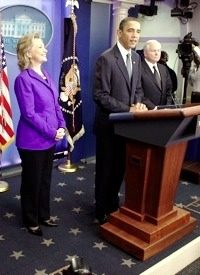
VOA News reported on March 25 that the United States and Russia have announced that a new strategic arms agreement will be formally announced when the presidents of both countries have spoken with one another about it. White House and Russian Foreign Ministry spokesmen say the conversation is expected soon.
VOA — an official U.S. government news agency — stated: “A new accord would set an auspicious tone for President Barack Obama’s nuclear summit in Washington on April 12 and 13. The agreement faced difficult negotiations, and more problems could emerge during ratification in the U.S. Senate.”
The report noted that the 1991 Strategic Arms Reduction Treaty (START) signed by the United States and the old Soviet Union reduced both sides’ nuclear arsenals from tens of thousands of warheads to about 6,000.??Secretary of State Hillary Clinton promised to work closely with Russia to sign a new agreement for further reductions. She spoke in Geneva nine months before START was to expire in December 2009.
"There is a lot of work to be done," Clinton said. "We think this is a fresh start, not only to improve our bilateral relationship but to lead the world in important areas, particularly with respect to nuclear weapons and nuclear security."
VOA noted: “During his visit to Moscow last July, President Obama said the United States and Russia must lead by example to reduce the threat of nuclear proliferation. He later reported progress toward that goal, even though the old START treaty had expired.”
The Washington Post described the agreement unequivocally: “The United States and Russia have reached a deal on their most extensive nuclear arms-control agreement in nearly two decades.”
The New York Times reported that President Obama and Russian President Dmitri Medvedev plan to talk on March 26 to complete the agreement, and cited officials who expressed optimism that the deal was nearly done. The report said that the United Stats and Russia have begun preparing for a signing ceremony in Prague on April 8, an event timed to coincide with the first anniversary of Obama’s speech in the Czech capital, wherein he outlined his vision for eventually ridding the world of nuclear weapons.
The Christian Science Monitor summarized the agreement as follows:
Experts say the new agreement, designed to replace the 191 Strateggic Arms Reductioin Treaty [START], will reduce strategic nuclear warheads by one-quarter, to around 1,600 on each side, and halve the number of delivery vehicles — missiles, bombers, and submarines — to 800 for each country.
The US currently has deployed around 2,150 strategic nuclear weapons; Russia reportedly maintains about 2,600. Both sides have thousands more in storage or awaiting dismantlement under previous arms control deals.
The Monitor also quoted Andrei Klimov, deputy chair of the Russian State Duma’s foreign affairs commission: "We cannot help but be pleased with this, because it finally removes headaches that should have been dealt with long ago. It’s very important to have this deal, because it enables us to move forward in a number of ways, and it sets an example for other countries."
This latest U.S.-Russian agreement is the culmination of over 50 years of propaganda designed to induce such an irrational fear of nuclear war that the American public will accept agreements that will disarm America’s nuclear capability and actually leave us more vulnerable to nuclear attack — or more likely — capitulation and surrender of our national sovereignty. It can be demonstrated that U.S. leaders going back as far as President John Kennedy have long proposed that the world’s nuclear weapons be placed under the control of the United Nations.
The fear of nuclear warfare was exacerbated by the launching of the original Sputnik satellite by the Soviet Union in 1957, months after U.S. military was prevented by political higher-ups from launching its own satellite.
Emboldened by this propaganda victory, on September 25, 1961, President John F. Kennedy presented to the 16th General Assembly of the United Nations a disarmament proposal entitled, Freedom from War: The United States Program for General and Complete Disarmament in a Peaceful World (State Department Publication 7277).??
The "disarmament" called for by the document had much more to do with creating a monopoly of force for the UN than with weapons elimination. Excerpts from the document include:
??• "Disarmament shall take place as rapidly as possible until it is completed in [a program of three] stages containing balanced, phased and safeguarded measures, with each measure and stage to be carried out in an agreed period of time."
??• "As states relinquish their arms, the United Nations shall be progressively strengthened in order to improve its capacity to assure international security and the peaceful settlement of differences as well as to facilitate the development of international cooperation in common tasks for the benefit of mankind."??
• "By the time Stage II [of the three-stage disarmament program] has been completed, the confidence produced through a verified disarmament program, the acceptance of rules of peaceful international behavior, and the development of strengthened international peace-keeping processes within the framework of the U.N. should have reached a point where the states of the world can move forward to Stage III. In Stage III progressive controlled disarmament and continuously developing principles and procedures of international law would proceed to a point where no state would have the military power to challenge the progressively strengthened U.N. Peace Force and all international disputes would be settled according to the agreed principles of international conduct." (Emphasis added.)
It is no coincidence that the establishment of the UN so closely followed the detonation of atomic weapons on Hiroshima and Nagasaki by the U.S. military. If space allowed, we could demonstrate that those strikes were militarily unnecessary, but were executed as the beginning of a propaganda campaign waged to provide incentive for establishing a world governmental body backed by a military force superior to all of the world’s sovereign nations combined.
By actively pursuing this latest disarmament agreement, President Obama continues the legacy of his Democratic presidential predecessors who governed just before and during the UN’s founding period, Franklin D. Roosevelt and Harry Truman.?



